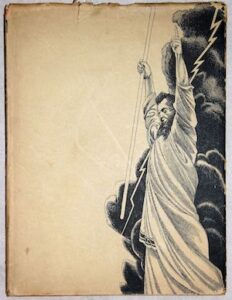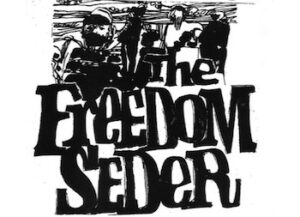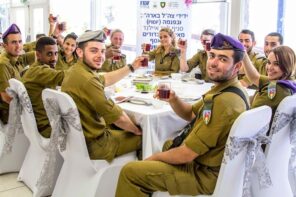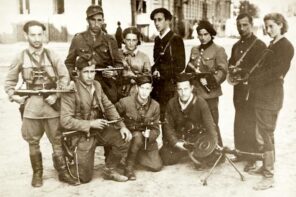Fifty years ago, on April 4, 1968, the transformation of my life began with the volcanic news that Dr. Martin Luther King had been killed. Just a week later—a week of upheaval in my city and our country—the volcano of transformation entered within me, minutes before Passover began.
Passover? Why was that suddenly so shattering? I had always taken the Seder seriously, but I was astounded to feel this moment shaking me to my core. Why was this Passover different from any other Passover?
I was 34 years old, living in Washington DC and working for peace and racial justice. I had grown up in a Jewish neighborhood in Baltimore with a strong sense that community, neighborhood itself, was warmly Jewish; that freedom and justice were profoundly, hotly “Jewish and beyond”—and that Jewish religion was boring boiler-plate.
Except for celebrating the Passover Seder, which brought family, community, freedom, and justice around the same dinner table, I had long abandoned the rhythms of Jewish religion.
So as a grown-up I had found my community not in any Jewish neighborhood but in the network of organizers for racial justice, peace in Vietnam, and world-wide nuclear disarmament—a network centered in the Institute for Policy Studies, where I had been one of the founding fellows in 1963.
And then Dr. King’s death and its aftermath in Washington undid me and rebirthed me.
I was not just a spectator to his passionate life and death. I had spent nine years in Washington working day and night against racial injustice and the Vietnam War—behind a typewriter on Capitol Hill; at the microphone on countless college campuses; sitting in unbearably hot back rooms of Convention Hall in Atlantic City in 1964, working alongside Dr. King when he came hobbling on a badly twisted ankle to rally support for the Mississippi Freedom Democratic Party; marching and sitting-down against the Vietnam War in 1967, at the Pentagon; cruising D.C. streets in a sound truck (with my four-year-old son beside me), to turn out votes for Bobby Kennedy in 1968.
On the evening of April 3, Dr. King spoke to a crowd in Memphis: “I’ve been to the mountaintop… And I’ve seen the Promised Land. I may not get there with you. But I want you to know tonight, that we, as a people, will get to the promised land!” Echoes of Moses. By the next night, he was dead.
By noon the next day, Washington, my city, was ablaze. Touch and go it was, whether 18th Street—four houses from my door—would join the flames. Just barely, our neighborhood’s interracial ties held fast. The President, who just a few days before had proposed peace talks with Vietnam, now begged the Black community to remain nonviolent—before, ironically, ordering the US Army to occupy the Nation’s capital city, taking over schools and traffic circles. A rifle-bearing soldier stood on the Capitol steps.
By April 6, there was a curfew. Thousands of Black protestors were being herded into jail for breaking it. No whites, of course; the police didn’t care whether white people were on the streets. My white friends and I tried to turn their blindness to good use: For days we brought food, medicine, doctors from the suburbs into the schools and churches of burnt-out downtown Washington.
And then came the afternoon of April 12. That night, Passover would begin. We would gather—my wife and I, our son, our daughter (just nine months old), with a few friends, for the usual ritual recitation of the Telling of our freedom. Some rollicking songs. Some solemn invocations. Some memories from seders of the past, in the families where our fathers had chanted—some of them in Hebrew or Yiddish, some in English.
But it was a bubble in time, a bubble isolated from the life, the power, the volcano of the streets. Perhaps, when the rituals were over and the kids had been initiated into the age-old ritual, had taken their first look into this age-old mirror in which Jews saw ourselves as a band of runaway slaves, we might put aside the ancient book and talk about the burning—truly, burning—issues of our lives.
So I walked home to help prepare to celebrate the seder. On every block, detachments of the Army. On 18th Street, a Jeep with a machine gun pointing up my block.
Somewhere within me, deeper than my brain or breathing, my blood began to chant: “This is Pharaoh’s army, and I am walking home to do the seder.”
“This is
Pharaoh’s
army,
and I am walking home
to do
the Seder.
This is
Pharaoh’s
army …”
King’s speech came back to me. “I’ve been to the mountaintop… And I’ve seen the Promised Land…” The songs we had sung in Atlantic City four years before with Fannie Lou Hamer, who had come from a Mississippi sharecropper’s shack to confront the Democratic Party: “Go tell it on the mountain, let my people go! … Must be the people that Moses led, let my people go!” The sermons I had heard Black preachers speak, half shouting, half chanting: “And on the wings of eagles I will bring you, from slavery, from bondage, yes!—from slavery, to be My people—yes, my beloved people.”
Yes, on the streets is Pharaoh’s army, and I am walking home to do the seder.
Not again, not ever again, a bubble in time. Not again, not ever again, a ritual recitation before the real life, the real meal, the real conversation.
For on that night, the Haggadah itself, the Telling of our slavery and our freedom, became the real conversation about our real life. The ritual foods, the bitterness of the bitter herb, the pressed-down bread of everyone’s oppression, the wine of joy in struggle, became the real meal.
For the first time, we paused in the midst of the Telling itself, to connect the streets with the seder. Every year since I had learned to read, I had recited the passage that says, “In every generation, every human being is obligated to say, ‘We ourselves, not our forebears only, go forth from slavery to freedom.’”
Amazing!—not “every Jew,” it says: “Every human being!”
In every generation. Including our own. Always before, we had chanted these passages and gone right on. Tonight we paused. Who and what is our oppressor? How and when shall we go forth to freedom?
To my astonishment, these questions burned like a volcano within me, erupting like the volcano in my city. Why did I care to make this connection? Why was this ancient tale having such an effect on me? How could I respond?
During the next six months, especially as a member of an antiwar, anti-racist delegation elected from D.C. to the Democratic National Convention in Chicago, some elements of the Passover story kept erupting inside me. The City of Chicago was infamously tyrannized by its Mayor, Richard Daley, who ordered a police riot to bloody nonviolent demonstrators against the war. While his police tyrannized demonstrators outside, the same Daley, as chairman of the Convention, tyrannized us delegates inside. Powerful teachings about the modern pharaohs!

Back cover illustration of Saul Raskin Haggadah.
In the fall, I found myself preparing for the next Passover by writing a Haggadah, a Telling of my own, a script for what I imagined would be our own family Seder. I hoped it would deliberately make happen in the future what had already happened, with no deliberation, in the midst of turmoil. I dug out my old Haggadah, the one I had been given when I turned 13, the one with Saul Raskin’s luscious drawings of the maidens who saved Moses from the river, the one that stirred my body each spring, those teenage years.
Into its archaic English renderings of Exodus and Psalms, I intertwined passages from King and Thoreau; Ginsberg and Gandhi; the Warsaw Ghetto Uprising against Nazism and the Nat Turner rebellion against slavery; the Christian radical A. J. Muste calling Moses the organizer of “Brickmakers Union Number 1” and a pacifist Russian rabbi named Tamaret—wove them all into a new Telling of the tale of freedom.
In that Telling, the then ongoing, even now unfinished, struggle of Black America for freedom was interwoven with the ancient story of the Israelites’ struggle to end their slavery under Pharaoh.
Where the old Haggadah had what seemed to me a silly argument about how many plagues had really afflicted Egypt, I substituted a serious quandary: Were blood and death a necessary part of liberation, or could the nonviolence of King and Gandhi bring a deeper transformation?
I had written half a dozen books—on military strategy, disarmament, race relations, American politics—but this was different: This book was writing me. I had no idea whether it made any sense to do this; I knew only that I could not stop. When I had finished, I called around to find a Washington rabbi who might be sympathetic. I asked him—Rabbi Harold White—to read my draft: Was this a crazed obsession or a good idea?
Two days later, he called me: “I love it, Waskow. It’s an activist midrash on the Haggadah! You’ve taken the story into our own hands, as the rabbis said God wanted the fleeing slaves themselves to do. Do you know that midrash? The one where God refuses to split the Red Sea until one activist has gone into the water, up to his nose, about to drown?”
“What’s a midrash?” said I.
“Oho!” said he, and even over the phone I could feel the excitement rise. “The rabbis would take the ancient text, and read it in new ways. On this one, where the Torah says the people ‘went into the sea on the dry land,’ the rabbis ask, ‘Which was it? How could it be both sea and dry land?’ And they answer that one of them went in while it was still sea; only then did it become dry land.
“You see?—the people had to act. The rabbis took the text into their own hands because they wanted the people to take history into their own hands. The text at first glance seems to leave the action to God; but the rabbis reread this oddity of text to mean the people acted.
“That’s midrash. Can I share some midrash with you?”
So he lent me a volume of this “midrash,” and I fell in love. A whole new language that my heart had searched for all these years, a whole new language I had never known existed. A language of transformation-through-renewal, a language that drew on an ancient language to make it deeply new. A language of serious play that could, with a wink and a twirl, turn reality in a new direction and claim it was simply uncovering a meaning that was already there. A language of puns, serious and funny puns that took as cosmic teaching the clang of words and phrases with each other.
And this, the rabbi taught me, was what my new Haggadah was already: a midrash on the ancient text that turned it in a new direction. What neither he nor I expected was that as I was reinterpreting the text, the text was reinterpreting me. Turning me in a new direction, making a new “I” that was a midrash on the old me.
So I went ahead with the transgressive, transformative Haggadah that eventually was called “The Freedom Seder.” In 1969 it was published in Ramparts magazine, where tens of thousands greeted it with joy: a religion they could share!
 And on April 4, 1969, the first anniversary of Dr. King’s murder and the third night of Passover, we held a Freedom Seder in the basement of a Black church in Washington DC, with about 800 people, Jews and Christians, Black and white.
And on April 4, 1969, the first anniversary of Dr. King’s murder and the third night of Passover, we held a Freedom Seder in the basement of a Black church in Washington DC, with about 800 people, Jews and Christians, Black and white.
It was not only my engagement with the Jewish text, with all the Jewish texts, that “rewrote” me. It was also my engagement with other Jews who were rewriting themselves, my engagement with communities that came together in the very process of wrestling with these texts.
For indeed, it turned out that others were entering this process, stirred by events in their own lives as I had been stirred by the streets of Washington. Stirred, some of them, by their need for community, and what many of them felt was the chilliness of conventional Jewish life. Stirred, some others, by their own spiritual yearnings and the flatness of what they had experienced as conventional Jewish life. Stirred, still others, by their hopes and fears for the State of Israel, which had stood on the edge of deeply dangerous waters in 1967, and crossed—they thought—in triumph.
But even that early, some were stirred to worry about warnings of a long Occupation. Some who had never been welcomed into the hidden places of Jewish thought and practice, were stirred by the joy and triumph they saw as Blacks refused to melt into America, and instead unfurled the hidden flags of their own culture. Still others—mostly women—were stirred by the possibility of reshaping the Judaism that had always ignored their needs and their perceptions. Still others who already had deep knowledge of hidden Jewish wisdom, were stirred by the unexpected feeling that those riches could give new meaning to their lives.
And I found seeds and sprouts of a fiery Judaism where the Burning Bush was still aflame. I learned of a Rabbi named Heschel, who had marched alongside King at Selma.
Who had stood beside King when, exactly a year before his death, King spoke the words that some said were the warrant for his murder: Denouncing the US War Against Vietnam as an atrocity, warning that the deadly “triplets” of racism, materialism, and militarism were endangering America.
Who had stood beside King in Arlington Cemetery as they mourned the war dead—American and Vietnamese.
Who could write in the same essay that prayer was the joyful song the universe sang to itself, and that prayer was meaningless unless it was subversive.
Who had arranged with Dr. King to celebrate his first Passover Seder in 1968 with the Heschel family. The Passover when, though King was dead—because he was dead—he lived in thousands of seders across America, including mine. A living proof of death and rebirth, if not of resurrection.
And others who like Heschel had kept the Burning Bush aflame, even when their passion was criticized by colleagues—as indeed Heschel’s colleagues at the Jewish Theological Seminary did, scorning his activist passion even while they admired his theology and scholarship.
Because I discovered I was not alone, because there were others for me to meet upon my journey, my journey became possible. As we discovered each other, we granted each other the truths of our own different stories, ultimately the truth that we could share a journey of many different journeys. We discovered how astonishingly rich were the Judaisms—plural—we had barely known, and how our forebears also had walked many different paths. And we discovered how astonishingly nourishing were the new Judaisms we ourselves could shape as we intertwined our own lives with each other and with the lives of our forebears.
But the process didn’t end there; it simply began. Looking back, I can see that the Freedom Seder was the moment and the act through which I truly became a bar mitzvah: through it, I entered the gates of Jewish life; through it, I became an adult, shaping my own life. Given who I was, it was the only gate I could have taken: one I had to build myself.
And by the same token, looking back, I can see how it was the entry gate that a newcomer would build: clumsy, intuitive, marked by a blunder here and a blemish there, yet powerfully attractive to others who connected with its impulsive energy.
Plenty of people said I had no right, so new and raw, to raise the Jewish roof—but I was also able to find a community of searchers, for whom learning came out of the searching.
This process has now been the living center of my life for half a century. I have moved to a different city, taught and learned in different schools, prayed in different gatherings from other prayer-books I have helped to write myself. I was drawn to a new understanding of the early rabbis as radicals, and studied to become a rabbi as radical as they had been—a rabbi who could join a rabbinate that was a midrash on rabbinic tradition. (Now I know what midrash is, and revel in the knowing.)
A feminist midrash on Judaism and the rabbinate. An ecological midrash on Judaism and the rabbinate. A transformative midrash on Judaism and the rabbinate, seeing Judaism as one wisdom among others looking toward the healing of our wounded country, our wounded world, our wounded Mother Earth.
Indeed, I have learned to understand midrash and all of Jewish time and Jewish thought as a spiral: neither a straight line that must go always forward, even into a precipice, nor a circle that must remain forever stuck in repeating past experience. Instead, a spiral, which curves always backward in order to curve forward.
Fifty years after that volcano erupted in my soul, I see it’s time for another turn of the spiral. Facing Pharaoh in the White House and in the Corporate Carbon Pharaohs intent on burning our Earth to pile still higher pyramids of profit, I realize that never again can the Seder freeze. Now, again, we need a new Freedom Seder. “In every generation …” Indeed.
What makes time and life into a spiral, instead of a straight line or an endless circle, is setting aside time for reflection, rest, renewal. That renewal-time—Shabbat, the Sabbath; each pause to bless Creation and say I-Thou before we make use of it; the Great Shabbat when, we are taught, we must let the Earth have its own restful year—is the curve that moves the spiral onward.
Indeed, now I understand midrash itself as a spiral, in which we go back again and again in order to go forward. We draw on ancient wisdom to create new wisdom. What went before, we turn and turn like a kaleidoscope. With every turn, new beauty, new patterns, new complexity.
Facing new versions of the world. Birthing new versions of ourselves.
***
Download the “MLK + 50 Freedom Seder” from the Shalom Center, here.





